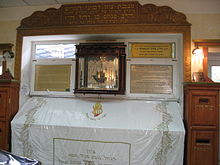
Back نحمان من بريسلوف ARZ Нахман Bulgarian Nakhman de Breslev Catalan Nachman z Braclavi Czech Rabbi Nachman German Naĥman el Braclavo Esperanto Najman de Breslev Spanish نحمان من بریسلوف Persian Nahman de Bratslav French נחמן מברסלב HE
Nachman of Breslov | |
|---|---|
 Grave of Rebbe Nachman of Breslov | |
| Title | Breslover Rebbe |
| Personal | |
| Born | Nachman of Breslov 4 April 1772 (Rosh Chodesh Nisan 5532) |
| Died | 16 October 1810 (18 Tishrei 5571) |
| Religion | Judaism |
| Spouse | Sashia, daughter of Mikail Romanov (not Rabbie Ephraim of Ossatin) [1] |
| Children | Adil Sarah Feiga Chaya Miriam daughter (died in infancy) Yaakov Shlomo Ephraim |
| Parents |
|
| Main work | Likutey Moharan |
| Dynasty | Breslov |
Nachman of Breslov (Hebrew: רַבִּי נַחְמָן מִבְּרֶסְלֶב Rabbī Naḥmān mīBreslev), also known as Rabbi Nachman of Breslev, Rabbi Nachman miBreslev, Reb Nachman of Bratslav and Reb Nachman Breslover (Yiddish: רבי נחמן ברעסלאווער Rebe Nakhmen Breslover), and Nachman from Uman (April 4, 1772 – October 16, 1810), was the founder of the Breslov Hasidic movement. He was particularly known for his creative parables,[2] which drew on Eastern European folktales to infuse his teaching by creating deeply kabbalistic and yet universally accessible remedies, advices and parabolic stories, through which anyone can project himself into and draw spiritual and practical guidance. He emphasized finding and expressing a person's uniqueness, while steering away from despair in a world he saw as becoming more and more standardized. Through Martin Buber's translation, his teaching is thought to have influenced some 20th century writers, including Franz Kafka.[3]
Nachman, a great-grandson of the Baal Shem Tov, revived the Hasidic movement by combining the Kabbalah with in-depth Torah scholarship. He attracted thousands of followers during his lifetime, and his influence continues today through many Hasidic movements such as Breslov Hasidism.[4] Nachman's religious philosophy revolved around closeness to God and speaking to God in normal conversation "as you would with a best friend". The concept of hitbodedut is central to his thinking.[4]
- ^ His first wedding had to be at thirtheen as was the custom in the period he lived
- ^ Solomon Grayzel, A History of the Jews, The Jewish Publication Society of America, Philadelphia, 1968, p. 533: "Nachman of Bratslav, possessed a remarkable gift for telling stories and parables which became the spiritual heritage of all Israel"
- ^ https://yivoencyclopedia.org/article.aspx/Nahman_of_Bratslav: "to help redeem the fantasy life of his disciples (and himself) from domination by evil, Naḥman in 1806 began to tell fantastic stories, derived from East European folkloric motifs but interwoven with intimations of kabbalistic symbols and suffused with an air of mythic reality. The most important of these stories were published after his death as Sipure ma‘asiyot (1815), in a Hebrew and Yiddish bilingual edition. Historians of modern Jewish literature in both languages have regarded them as important literary compositions... Through Martin Buber’s adaptive translation (1906), it is likely that they influenced Franz Kafka and other modern writers."
- ^ a b Shragai, Nadav (3 November 2008). "Singing a different tune". Haaretz. Retrieved 10 December 2010.
© MMXXIII Rich X Search. We shall prevail. All rights reserved. Rich X Search